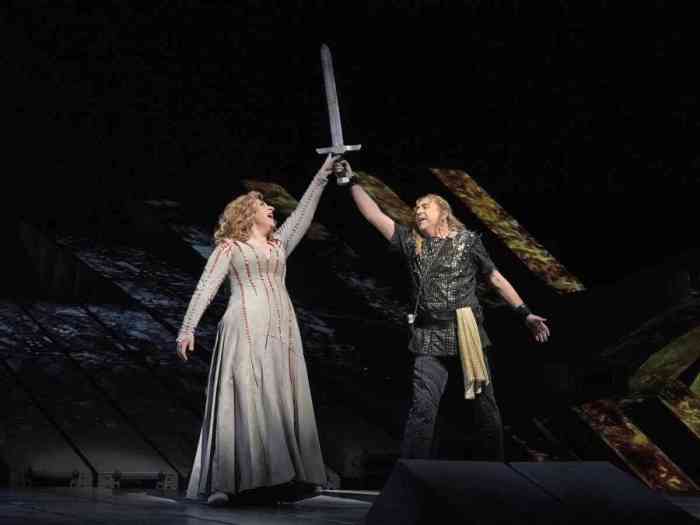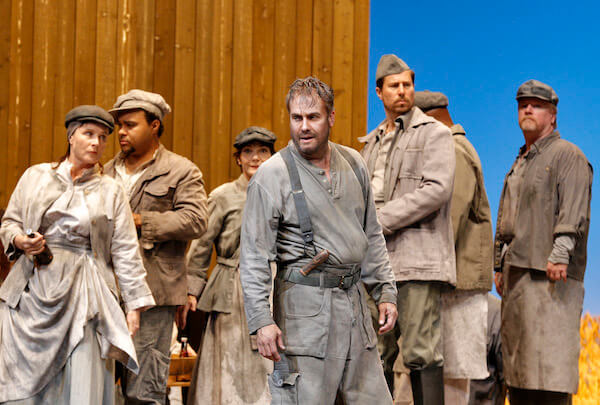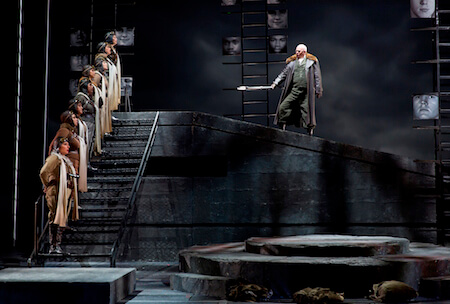Nina Stemme and Stuart Skelton in Mariusz TreliÅ„ski’s production of Wagner’s “Tristan und Isolde” at the Metropolitan Opera. | KEN HOWARD
BY ELI JACOBSON | The Metropolitan Opera opened its 50th season at Lincoln Center on September 26th with a musically powerful new production of Wagner’s “Tristan und Isolde.” Mariusz TreliÅ„ski’s bleakly pessimistic production premiered earlier this year in Baden-Baden to mixed reviews. However, the Met has assembled a musical dream team of Wagnerian heavy hitters: Nina Stemme as Isolde, Stuart Skelton as Tristan, Ekaterina Gubanova as Brangäne, Evgeny Nikitin as Kurwenal, and René Pape’s still-definitive King Marke — all led by Sir Simon Rattle.
TreliÅ„ski’s production is set in a dystopian military-industrial society sometime in the last century. As in his nightmarish production of “Duke Bluebeard’s Castle” two seasons ago, surreal dream imagery breaks into the brutal world of everyday existence — the inner “night” world of the psyche invades the “day” world of cruel reality. For TreliÅ„ski, both worlds are dark and fixated on death.
TreliÅ„ski was trained as a filmmaker and uses cinematic effects like crosscutting to different locations, flashback, and montage in a theatrical setting. Video projections by Bartek Macias are screened on the show curtain and on partial scrims that break up the massive three-tiered battleship set. The projections show abstract images of sonar screens and the ocean, flashbacks from Tristan’s tragic childhood, and close-ups of Isolde’s face.
Stark “Tristan ” from Mariusz TreliÅ„ski marshals top flight cast in break from Wagner’s passion
The Act I curtain comes up on the multi-level interior of a battleship (designed with impressive scale and detail by Boris KudliÄka). Costume designer Marek Adamski dresses the women in drab dark clothes while the Tristan and Kurwenal are officers in naval uniforms. The ship is a floating prison of metal and glass patrolled by armed black-clad soldiers who physically intimidate and harass Isolde and Brangäne. Violence seems to be a fact of life – Isolde shoves Brangäne about and later threatens Tristan with a handgun. Tristan, who obviously has a death wish, gives Isolde his gun and helpfully guides the muzzle to his temple during their confrontation before drinking the love potion.
Act II, usually set outdoors in a castle garden evoked by rustling strings, now takes place on the fog-bound pilothouse of the same ship. Nature and beauty are totally absent from TreliÅ„ski’s production concept. Images of an Aurora Borealis are projected on the black show curtain during Brangäne’s warning, and the set changes into the lower cargo hold of the ship.
False notes intrude — the fuel barrels and fans hardly evoke nocturnal passion and sensuality. Floodlights aimed at the audience are substituted for Isolde’s torch signal, turning on and off in defiance of the libretto and inducing headaches. A gate in the back opens by itself, sabotaging a potentially thrilling coup de théâtre when Marke and Melot later enter through it, surprising the lovers.
Other touches are intellectually provocative: Tristan’s final plea to Isolde in Act II is played as a hallucinatory monologue addressed to a dream Isolde. Self-destructive Tristan “accidentally” shoots himself in a struggle with Melot and Marke’s guards.
Act III is set in what looks like the sick bay of the same ship, with Tristan lying on a hospital gurney. During Act III’s static 45-minute internal monologue/ endurance test for the tenor, Tristan mentally travels back to his childhood home, Kareol, occasioning another set change. Isolde, after finding Tristan dead, slashes her wrists. During the Liebestod, the dying Isolde seems to join Tristan in his dark inner world. The late entry of Marke and Brangäne onto the scene and Kurwenal’s death are confusing — we don’t see Kurwenal die and can’t tell if these people are real or hallucinations in Isolde’s fading consciousness. TreliÅ„ski’s staging is anything but static (unlike the Dieter Dorn “Son of Wieland Wagner” production it replaces) but is visually grim and alienating.
Suitably, since TreliÅ„ski’s production emphasizes the antiheroic flawed aspects of these characters, most of the voices are human-sized. Nina Stemme’s dark soprano fulfills all of Wagner’s basic requirements. The dark central core of her soprano holds firm against Wagner’s orchestra. But the top register (including firm high C’s) doesn’t soar and the middle register doesn’t envelop the listener with beauty and warmth. Stemme’s volume is adequate but not overpowering, and her vibrato can widen under pressure — not enough however to obscure line and pitch. Vocally, she has everything under control and her vast experience in the role is reflected in expert pacing and textual delivery.
In Acts II and III, Stemme aims for lyricism and, with less pressure, her soprano blooms — hardworking efficiency gives way to silvery radiance. Above all, Stemme is supremely musical and leaves no detail untouched by her artistry. TreliÅ„ski emphasizes Isolde’s anger over feminine vulnerability and sensuality — her costumes are dark and shapeless, her hair straggly. Stemme’s acting therefore comes off more earnest and charmless than necessary.
After an unfocused and unsteady opening night, Australian heldentenor Stuart Skelton gained stamina and control by the third performance on October 3 — he was the revelation of the evening. Skelton’s baritonal middle range opens up into a sweetly lyrical if occasionally pressed upper register. He even summoned phrases of Schubert-lied-delicacy in Act III after passages of agitated declamation. Despite one or two momentary lapses into strain or shouting, Skelton’s voice held up to the last floated “Isolde” of Act III.
Evgeny Nikitin’s high bass was tested by Kurwenal’s baritone high notes in Act III — but a little roughness is appropriate for the character and he is an arresting voice and stage presence. Ekaterina Gubanova’s rich mezzo-soprano communicated Brangäne’s sympathetic anguish at Isolde’s plight with steady legato phrasing. René Pape has delved further into King Marke’s anguish — this strong man has not one ounce of self-pity, just shock and disillusion at Tristan’s dishonorable betrayal. Pape still rolls out a velvet carpet of enveloping bass tone — and won ovations for it.
Sir Simon Rattle’s conducting is forward moving with a transparency of detail that does not preclude force or depth. The Met Orchestra seemed inspired by him, playing with flawless ensemble and balance, never overwhelming the soloists. Rattle favors a cool cerebral reading with much in common with Pierre Boulez’s “Tristan” interpretation. There is constant agitation and tension but little sensuality or Dionysian ecstasy in his interpretation — very in tune with TreliÅ„ski’s production.
TreliÅ„ski’s vision of “Tristan” is dark, aesthetically bleak, and passionless — the lovers escape into alternate realities to avoid the ugly one they live in. Love leads to death with little pleasure in the journey. This production concept reflects the philosophy of Schopenhauer, who influenced Wagner’s libretto for “Tristan.” But old Richard was also very much a sensualist, and TreliÅ„ski’s interpretation, though provocative, shortchanges aspects of the work. This “Tristan” aims to disturb and challenge, not seduce the audience.


































